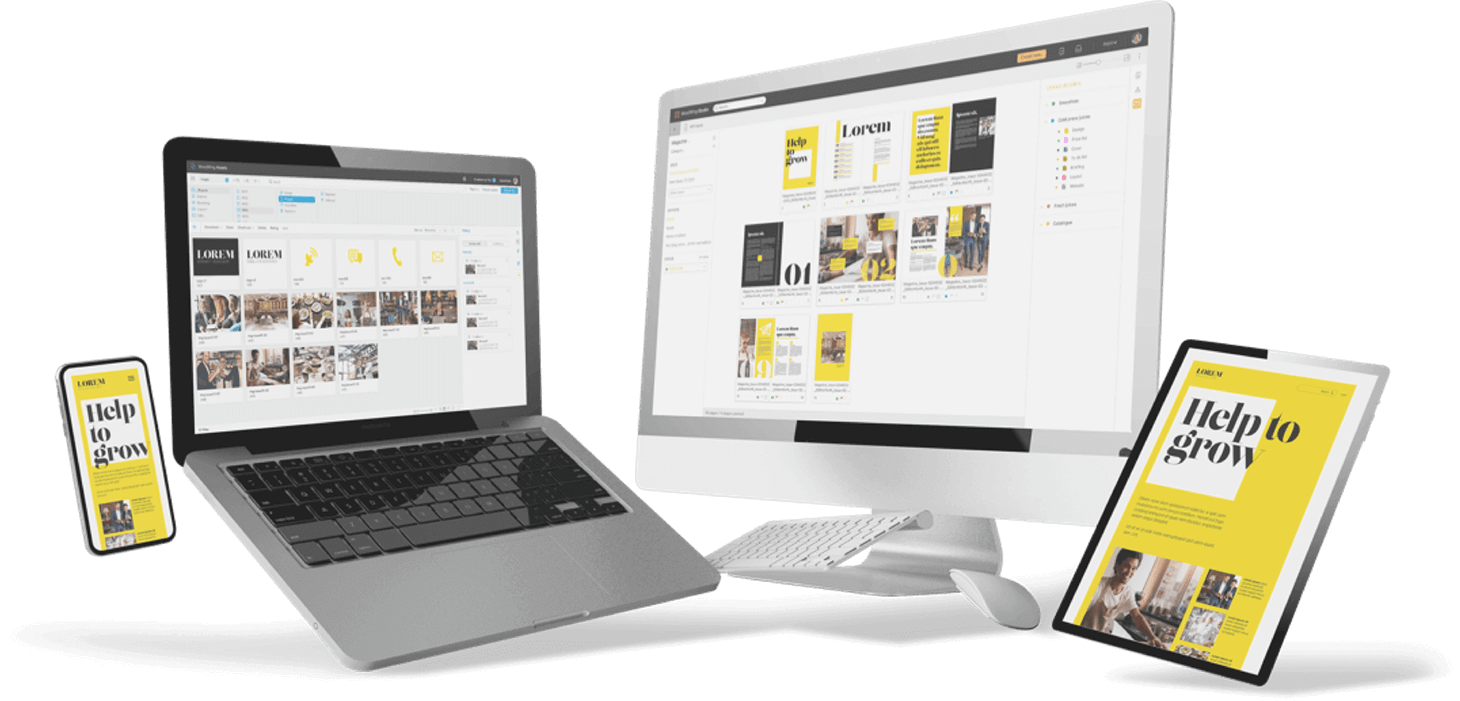From member magazines to directories, emails to academic journals, training materials to gated resources, your content is a key member benefit. This means organizations like yours are becoming more like publishers every day.
But if you’re not using publishing software to manage content creation effectively, you could be wasting time and money. And that’s time and money you could spend on additional activities to attract and retain members.
Here’s our introduction to key publishing technology for membership-based organizations. And how it can help you scale and speed up production, cut costs and complexity, and boost your benefits package.
Why content creation needs careful management
Access to exclusive content is a key benefit in many membership organizations. Publishing content that your organization is uniquely qualified to create makes membership a ‘must have’.
That might include:
- sector reports and thought leadership
- specialist training resources and webinars
- journals annuals or member magazines
- industry updates via email and online
- exclusive gated web resources and tools
Whichever sector you serve, creating unmissable content should be at the heart of your membership growth and retention strategies. And if you’re a savvy membership organization, the likelihood is you’re looking to increase your content offer.
But ambitious content plans mean more complexity.
Managing contributors and feedback processes - Every piece of content can involve multiple contributors - from subject matter experts to writers and designers - which requires effective management of planning, creation, review and sign-off.
Keeping track of digital assets - Then there are the individual digital assets that make up your content - photos, graphics, video, audio, logos and more. Without careful management, finding digital assets can become a major time sink.
Protecting your brand - Finally let’s talk brand. If you have regional offices or volunteer-led working groups, there’s a risk of well-meaning but poorly executed content undermining your brand visual identity. Not ideal.
As a result of this content complexity, many organizations leak time and money. Processes that aren’t fit-for-purpose cause systematic loss of productivity and efficiency. And that undermines your ability to deliver your content plans - let alone scale up content creation. All of which makes managing your content processes a strategic imperative.
Fortunately, there is publishing software that can address these challenges - and make it easier than ever for your organization to create value-adding, on-brand content at scale.

Publish effortlessly to every platform with WoodWing software
Discover WoodWing publishing solutions for membership organizations
Best publishing software for membership organizations
Editorial workflow software
An editorial workflow system is designed to make managing content creation processes easier. Content progresses through a pre-agreed workflow, getting sent automatically to anyone who needs to contribute. Alerts flag up when action is needed and individuals can see their personalized to-do list at a glance.
Software like WoodWing Studio even includes design stages, so you can manage projects from copywriting to publication in a single place, with complete transparency throughout. Read more benefits of editorial workflow software.
Digital asset management software
A digital asset management system provides a single source of truth for all of your images, graphics, video, logos, and more.
Using a DAM means you can always find the asset you need in as little as three clicks. No more rummaging through files and folders. Everything is at your fingertips. You can search on a huge range of metadata - like keywords, names or image orientation - to find the perfect assets for your project.
You can even integrate your DAM with other software so you can find assets from your design apps, CMS, editorial workflow, and project management software.
Brand template software
Brand template software empowers employees and volunteers to instantly create on‐brand, customized artwork from templates. Simply set up templates for everything from social posts to posters and flyers. Then delegate design work without the worry of wacky fonts, off-brand imagery, or outdated logos.
Three benefits of publishing software for membership organizations
1. Boost member benefits - create more content
If you’re looking to increase or improve the content you provide to members, publishing software can help you scale your output without additional resources.
That’s because fit-for-purpose publishing software eradicates systematic inefficiencies that can undermine your best efforts:
- Manually managing complex workflow processes
- Wasted time tracking down digital assets
- Servicing requests for brand assets and policing outputs
Publishing software can solve all of these challenges. But how? Unless you’ve used publishing software before, you might not be able to imagine its transformative impact.
But using the right publishing software can make it easier, faster, and cheaper to create great content by:
- Automating workflows and notifying contributors when they’re needed
- Eradicating time-wasting manual processes and boosting productivity
- Providing a single shared space for review, feedback, and approval
- Putting the right digital assets at your fingertips for every project
- Empowering employees and volunteers to self-serve brand assets
- Creating instant designs from pre-agreed templates
- Preparing and dispatching content for publication to print and web
This means you can create the same content with less time and money - and you can use those savings to invest in other value-adding activities for your members.
Alternatively, you can increase your content output without needing additional staff or resources. This makes scaling your content creation a viable option for membership organizations of any size.
Whether you choose to save money, increase outputs, or achieve both, publishing tech should be part of your content strategy.
2. Effortlessly manage journal production
If your membership organization creates flagship publications - such as academic journals or an annual directory - you’ll be used to complex production processes.
You will probably have a large number of contributors and a rigorous approval process. With academic journals, this is likely to include several rounds of peer review with multiple reviewers. That’s a lot to manage.
Many organizations manage submissions and publication progress using office tools like email, spreadsheets and databases. These certainly help you keep track of what’s where. But they take a lot of manual intervention and mental effort to maintain. They’re time-consuming and prone to human error.
An editorial workflow system - as described above - eradicates this manual and mental effort by automating editorial workflows.
Pre-defined editorial workflows mean that individual pieces of content - like articles or business listings - automatically progress through the right contributors to sign off. Collaborators can create, edit, approve and sign-off copy from a central hub.
Administrators can see content progress at a glance and individual contributors can see a personalized to-do list to keep them on track. Alerts and reminders keep projects flowing with minimal manual intervention.
For academic journals especially, this system can be a real selling point for future editorial boards. It provides a simple-to-use, streamlined system that makes life easier for busy academics. And it provides 24/7 access from anywhere with internet access, ideal for international contributors.

3. Double down on brand and design
Brand and design can be a challenge for membership organizations. You may not have in-house design expertise to create beautiful branded content.
And, even if you do, regional offices and individuals may need to produce designed content without the relevant tools or skills. This can risk poor execution and brand dilution.
Publishing software can help protect and strengthen your brand - and increase the speed and quality of content design - whether you have in-house design team or not.
Some editorial workflow tools - like WoodWing Studio - progress projects all the way from copywriting to publication. They include design tools to create layouts for print and web using pre-defined templates. That means you can send your approved copy into agreed templates at the click of a button, and see web pages or print layouts come to life instantly.
Another option is a separate brand template tool. This is helpful for organizations where individuals need to create branded collateral - such as posters and leaflets. They empower non-designers to create content with ease by adding copying and images to branded templates.
If you’re lucky enough to have an in-house designer, integrating a DAM system into your software stack can be a real time-saver. Integrating DAM with your design software and CMS lets designers access your digital assets from within those applications. This seriously streamlines the design process and reduces friction between systems.
With the right tools at hand, your membership organization can increase the speed and consistency of branded output - empowering everyone to create designed materials in a fraction of the time. Which in turn helps boost brand awareness, recognition and loyalty.
Whether intentionally or not, membership organizations are becoming more like publishers. And as such, need to embrace tried-and-trusted publishing technology to make at-scale content creation easier and more efficient.
WoodWing has been supporting publishers to transform their processes, productivity, and profitability for over twenty years. Our publishing software is used the world over by ambitious content creators, marketers, agencies and brands looking for competitive advantage.
Give your members more with content orchestration
Ready to increase quality, quantity and control of your membership content?
Book your free, no-obligation demo of our content orchestration software for business and industry associations today.



